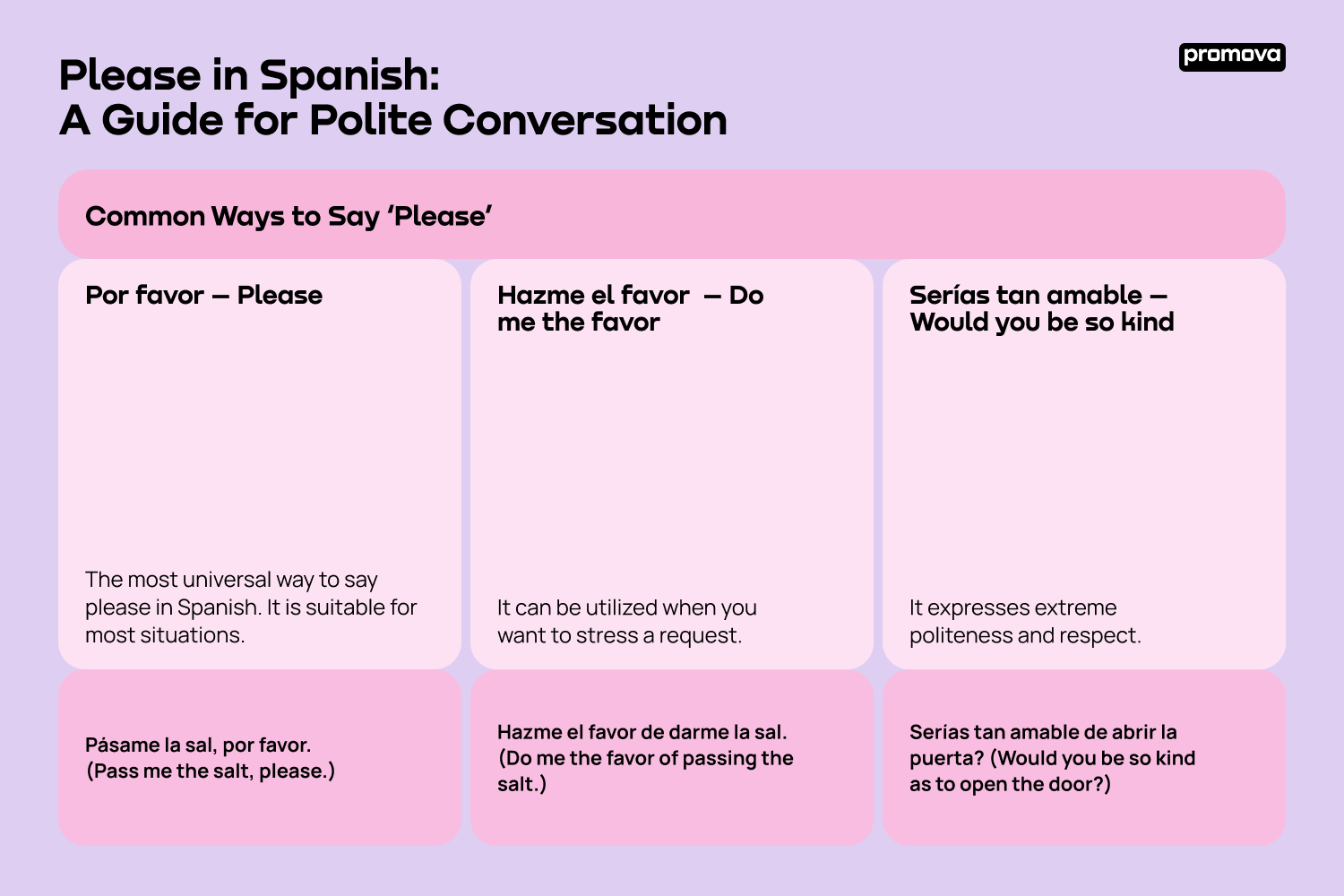Please in Spanish: A Guide for Polite Conversation

Contents
Spanish language etiquette goes much further than just Hola [ˈola] and Adios [aˈðjos]. The right phrase at the right time does matter very much. Saying please in Spanish is a must for all the people who want to talk politely. Many phrases exist for this purpose, and it is crucial to know which one to use in a specific situation. Read our article and get the hang of the expressions for different contexts.
Common Ways to Say ‘Please’ in Spanish
‘Please’ is one of the Spanish words for beginners that everyone should know. How you express it depends on the context and the person you’re talking to. Below are the most common phrases:
- Por favor [poɾ faˈβoɾ] – Please. The most universal way to say please in Spanish. It is suitable for most situations.
Pásame la sal, por favor. [ˈpasame la sal, poɾ faˈβoɾ] (Pass me the salt, please.)
- Si no te importa [si no te imˈpoɾ.ta] – If you don’t mind. A polite way to preface a request that might inconvenience someone.
Si no te importa, ¿podrías ayudarme? [si no te imˈpoɾ.ta, poˈðɾi.as aʝuˈðaɾ.me] (If you don’t mind, could you help me?)
- Si es posible [si es poˈsi.βle] – If it’s possible. This phrase for please in Spanish shows you understand your request might not be easy to fulfill.
¿Si es posible, ¿podrías salir temprano? [si es poˈsi.βle, ¿poˈðɾi.as sa.liɾ tem.pra.no] (If it’s possible, could you leave early?)
- Hazme el favor [ˈaθme el faˈβoɾ] – Do me the favor. It can be utilized when you want to stress a request.
Hazme el favor de darme la sal. [ˈaθme el faˈβoɾ de ˈdaɾ.me la sal] (Do me the favor of passing the salt.)
- Serías tan amable [seˈɾi.as tan aˈma.βle] – Would you be so kind. It expresses extreme politeness and respect.
Serías tan amable de abrir la puerta? [seˈɾi.as tan aˈma.βle de a’βɾiɾ la ‘pu̯eɾ.ta] (Would you be so kind as to open the door?)

Formal Context: How to Say Please in Spanish
There are specific ways to say ‘please’ in Spanish during formal situations. Correct usage makes your speech seem respectful and thoughtful. Explore the phrases for formal settings below:
- Te ruego [te ˈrweɣo] – I ask you. It is used for a sincere request.
Te ruego que escuches atentamente. [te ˈrweɣo ke esˈkuʧes a.tenˈta.mente] (I ask you to listen carefully.)
- Haga el favor [ˈaɣa el faˈβoɾ] – Do the favor. Common in professional or formal interactions.
Haga el favor de cerrar la puerta. [ˈaɣa el faˈβoɾ de seˈraɾ la ˈpweɾ.ta] (Do the favor of closing the door.)
- Le solicito [le so.liˈθi.to] – I request. An official and very polite way to ask.
Le solicito que me entregue el informe para mañana sin falta. [le so.liˈθi.to ke me enˈtɾe.ɣe el inˈfoɾ.me pa.ra maˈɲa.na sin ˈfal.ta] (I request that you give me the report without fail for tomorrow.)
- Favor de [ˈfa.βoɾ ðe] – Please do. Common in formal instructions or requests.
Favor de firmar al pie de esta página. [ˈfa.βoɾ ðe firˈmaɾ al pje ðe ˈes.ta ˈpa.xi.na] (Please sign at the bottom of this page.)
- Se ruega [se ˈrwe.ɣa] – It is requested. Often used in formal notices or announcements.
Se ruega silencio durante la conferencia. [se ˈrwe.ɣa siˈlen.θjo ðuˈɾan.te la kon.feˈɾen.θja] (Silence is requested during the conference.)
- Le imploro [le imˈplo.ɾo] – I implore you. It is for a very serious and formal request.
Le imploro que tome en cuenta nuestra situación. [le imˈplo.ɾo ke ˈto.me en ˈkwen.ta nuesˈtɾa si.twaˈθjon] (I implore you to consider our situation.)
- Permítame solicitarle [peɾˈmi.ta.me so.liˈθi.taɾ.le] – Allow me to request. Suitable in business or professional contexts.
Permítame solicitarle que revise estos papeles. [peɾˈmi.ta.me so.liˈθi.taɾ.le ke reˈβise ˈes.tos paˈpe.les] (Allow me to request you to review these papers.)
Please in the Spanish Language: The Informal Approach
When someone asks a friend or a relative for a favor, informal vocabulary is usually used. Expressions differ from region to region and depend on individual preferences. The following are examples of what is please in Spanish informal situations:
- Porfa [ˈpoɾ.fa] – Please (shortened). A more casual form of por favor. It’s often used among friends or in less formal situations.
Vamos a la playa, porfa. [ˈβa.mos a la ˈpla.ʝa, ˈpoɾ.fa] (Let’s go to the beach, please.)
- Vale [ˈba.le] – Okay/Please. Used much in the same way as ‘okay’ in English, often at the end of a request to signal politeness.
Me pasas la cerveza, vale? [me ˈpasas la seɾˈβesa ˈba.le] (Could you pass me the beer, okay?)
- Porfi [ˈpoɾ.fi] – Please. This Spanish word for please is another informal and endearing diminutive of ‘por favor.’
Ayúdame con esto, porfi. [aˈʝu.ða.me kon ˈes.to, ˈpoɾ.fi] (Help me with this, please.)
- Te lo pido [te lo ˈpi.ðo] – I’m asking you. Expresses a sincere request among close friends and family.
Te lo pido, ¿podrías recoger a los niños después de la escuela hoy? [te lo ˈpi.ðo, poˈðɾi.as re.co’ʝer a los ni’ɲos des.pu’es de la es’kwe.la oj] (I’m asking you, could you pick up the kids from school today?)
- Anda [ˈan.da] – Come on/Please. This is an informal call to action equivalent to please in English. It’s commonly used between friends or people of similar age.
Anda, pasa la cerveza. [ˈan.da, ˈpa.sa la seɾˈβe.θa] (Come on, pass the beer.)
- Hazme el paro [ˈas.me el ˈpa.ɾo] – Help me out. Colloquial Mexican Spanish phrase used to ask for help informally.
Hazme el paro, necesito que alguien cuide al perro. [ˈas.me el ˈpa.ɾo, neˈse.si.to ke alˈɣjen ˈkwi.ðe al ˈpe.ro] (Help me out, I need someone to watch the dog, please.)
7
Other Words to Express Politeness in Spanish
The politeness of Spanish is not only a matter of using ‘please.’ You need to learn other Spanish terms and phrases that show respect and good manners. Here are a few words to use:
- Gracias [ˈɡɾa.θjas] – Thank you. The most common way to express gratitude in any situation.
Gracias por tu ayuda. [ˈɡɾa.θjas poɾ tu aˈʝu.ða] (Thank you for your help.)
- Disculpa [disˈkul.pa] – Excuse me. Used to get someone’s attention politely or to apologize for a minor inconvenience.
Disculpa, ¿puedes repetir eso? [disˈkul.pa, ˈpwe.ðes reˈpe.tiɾ ˈe.so] (Excuse me, can you repeat that?)
- Perdón [perˈðon] – Sorry. A versatile word for apologies or to politely interrupt.
Perdón por llegar tarde. [perˈðon poɾ ʎeˈɣaɾ ˈtaɾ.de] (Sorry for being late.)
- Mucho gusto [ˈmu.tʃo ˈɡus.to] – Nice to meet you. Expresses pleasure in meeting someone.
Mucho gusto en conocerte. [ˈmu.tʃo ˈɡus.to en ko.noˈθeɾ.te] (Nice to meet you.)
- Encantado/a [en.kanˈta.ðo/a] – Delighted/Pleased. Conveys a delight in dealing with someone.
Encantada de ayudarte. [en.kanˈta.ða ðe aʝuˈðaɾ.te] (Pleased to help you.)
- Por supuesto [poɾ suˈpwes.to] – Of course. Expresses agreement or affirmation politely.
Por supuesto, puedes contar conmigo. [poɾ suˈpwes.to, ˈpwe.ðes konˈtaɾ konˈmi.ɣo] (Of course, you can count on me.)
- A sus órdenes [a sus ˈoɾ.ðenes] – At your service. Shows readiness to assist or a formal way of saying you’re ready to help.
A sus órdenes para lo que necesite. [a sus ˈoɾ.ðenes paɾa lo ke neˈse.si.te] (At your service for whatever you need.)
- Estoy agradecido/a [esˈtoj a.ɣɾa.deˈθi.ðo/a] – I’m grateful. Articulates a deeper level of gratitude.
Estoy muy agradecido por tu generosidad. [esˈtoj ˈmuj a.ɣɾa.deˈθi.ðo poɾ tu xe.ne.ɾoˈsi.ðað] (I’m very grateful for your generosity.)
Common Mistakes to Avoid When Using Spanish Please
Even though it is a basic thing to use ‘please; in Spanish, it is easy to commit mistakes. Misuse can result in interpreting things wrongly or even offense. Below are common errors and ways to avoid them:
- Too informal with authority. Spanish culture upholds respect for authority. Porfa vs por favor is an example. Use the latter with people in positions of power.
- Incorrect verb form. Remember to use the correct verb form of ‘please.’ Use infinitive verbs when saying haga el favor [ˈaɣa el faˈβoɾ].
- Excessive politeness. It may puzzle locals. They might interpret it as irony or sarcasm in some situations. Choose with care when and which form of ‘please’ to use.
- Mispronunciation. Pronunciation matters in Spanish. Make sure you know how to pronounce key phrases.
You can say please in Spanish confidently if you practice and pay attention to the context. Identify the proper occasions and apply the correct form to enhance your communication further.
Promova: Your One-Stop Solution for Learning Spanish
If you want to learn Spanish, Promova is the solution. Our platform has many resources for all levels. We provide guided courses, interactive exercises, and vocabulary lists for both beginners and advanced students.
Our guided Spanish courses are designed to teach key language aspects. The lessons are systematic, each building from the prior ones. They cover important grammar rules, vocabulary, and practical usage. The courses also help students to gauge their progress over time.
The Promova app gives students options to study on the go. The software is available for Android and iOS, so everyone can get it from the Google Play Store or Apple App Store. Thanks to our easy-to-navigate lessons, you can learn for a few minutes each day or dedicate more time as your schedule allows.
Our blog provides more insight into language learning. It provides articles that delve into themes like Spanish accents or holiday traditions. You’ll also find recommendations on how to learn Spanish effectively or common mistakes to avoid.
Conclusion
The proper form of please in Spanish formal and informal situations is the mainstay of a successful dialogue. You can master these phrases and improve your interactions with some practice: integrate them into everyday conversations, take down the mistakes, and listen to native speakers. But politeness is not only about saying ‘please’ all the time; it is about choosing the proper moment and form to do it. Recall those words and try to understand them in the context.
FAQ
What are some effective strategies for remembering polite phrases?
Context practice aids you. Use polite words when you speak daily. Make flashcards that match phrases with situations or images.
What role do gestures play in conveying politeness in Spain?
Nods, eye contact, and the right smile can back your polite words with real depth. Also, a handshake or pat on the back shows friendliness and respect.
When to switch from formal to informal politeness in Spanish?
Gauge the relationship and setting. Begin with a formal language in official or unfamiliar situations. Move to casual talk as relationships grow more relaxed and close. Follow the suit if others change how they address one another.
Where can I learn other Spanish phrases?
You can use Reverso Context and WordReferrence if you want additional resources to enhance your vocabulary. Promova’s Spanish language learning app also offers an extensive library of phrases with their usage and context.
Comments